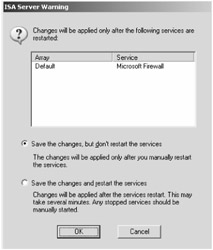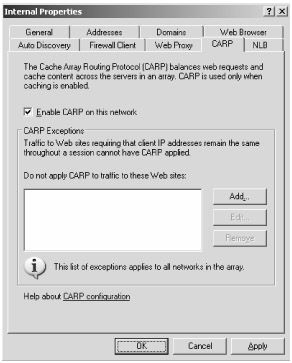Cache Array Routing Protocol (CARP)
CARP allows your clients access to a Web cache distributed across multiple ISA servers. For details on how CARP works, see the section "Cache Array Routing Protocol" in the ISA Server 2004 Help documentation. For our purposes, you simply need to know that enabling CARP means you can use the hard disk space available on all the servers in an array to create a single logical (though physically distributed) cache. ISA Server uses CARP to keep track of which servers use what content.
Only ISA Server 2004 Enterprise Edition supports CARP, as ISA Server 2004 Standard Edition doesn't support arrays.
Enabling Caching
CARP is dependent on caching being enabled on at least one member in an array, though for CARP to provide a benefit, you'll need two or more members. To enable caching, you will need to set the cache drive to a value greater than zero by following these steps:
-
Open the ISA Server Management console.
-
In the console tree, expand the Arrays node, expand the applicable array, expand Configuration, and then click Cache.
-
In the details pane, click the Cache Drives tab, and click your ISA server object.
-
In the task pane, under Cache Drive Tasks, click Define Cache Drives (Enable Caching).
-
On the Cache Drive tab, in the Maximum Cache Drive (MB) text box, specify a value represented in megabytes, click Set, and then click OK.
-
Click Apply to save your changes.
-
In the ISA Server Warning dialog box, shown in Figure 15-1, review your options, click OK, and then click OK after your changes have been incorporated.

Figure 15-1: You have the option to apply certain settings immediately by restarting the services, which might affect connected users, or to wait to restart the services at a later time.
Enabling CARP for Web Requests
In Microsoft ISA Server 2000, you could configure ISA Server to process CARP requests for either outgoing or incoming Web requests. This holds true in ISA Server 2004 except that, by default, CARP is not enabled unless you configure caching within an array. Another new distinction is that CARP is now configurable on a per-network basis. The following steps explain how to enable CARP for Web requests:
-
Open the ISA Server Management console.
-
In the console tree, expand the Arrays node, expand the applicable array, expand Configuration, and then click Networks.
-
In the details pane, click the Networks tab, right-click the network on which you would like to enable CARP, and then click Properties.
-
Click the CARP tab.
-
Select the Enable CARP On This Network check box as shown in Figure 15-2, and then click OK. Optionally you can add domain name sets within CARP exceptions for those Web sites that require the client IP address to remain the same throughout their session. Configuring CARP exceptions results in CARP remaining enabled for the network, but disabled for specific sites maintained on that network.
-
Click Apply to save your changes, and then click OK.

Figure 15-2: CARP can be configured on a per-network basis in ISA Server 2004 Enterprise Edition.
EAN: 2147483647
Pages: 173